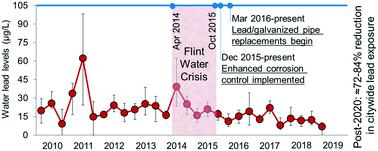当前位置:
X-MOL 学术
›
Environ. Sci.: Water Res. Technol.
›
论文详情
Our official English website, www.x-mol.net, welcomes your
feedback! (Note: you will need to create a separate account there.)
Efficacy of corrosion control and pipe replacement in reducing citywide lead exposure during the Flint, MI water system recovery
Environmental Science: Water Research & Technology ( IF 3.5 ) Pub Date : 2020-08-25 , DOI: 10.1039/d0ew00583e Siddhartha Roy 1, 2, 3 , Marc A. Edwards 1, 2, 3
Environmental Science: Water Research & Technology ( IF 3.5 ) Pub Date : 2020-08-25 , DOI: 10.1039/d0ew00583e Siddhartha Roy 1, 2, 3 , Marc A. Edwards 1, 2, 3
Affiliation

|
Flint biosolids monitoring data demonstrate a sustained decline in total lead release to potable water from plumbing since the 2014–2015 Flint Water Crisis (FWC), due to enhanced corrosion control treatment (3 mg L−1 orthophosphate as PO4) and removing of ∼80% of lead and galvanized iron service lines through early 2020. The official 90th percentile water lead levels, which have now met the federal Lead and Copper Rule threshold of 15 μg L−1 for the last four years, are in agreement with those predicted by a previously established biosolids regression model. There is also no longer a correlation between the percentage of children under 6 years of age with blood lead ≥ 5 μg dL−1 and biosolids lead mass in the 44 months post-FWC (Nov 2015–Jun 2019), nor are there continued correlations between plumbing-related metals in the biosolids, with the exception of Cu:Zn found in brass alloys that remain installed in homes. After Flint achieves 100% replacement of lead and galvanized service line pipes, a biosolids data analysis predicts that the remaining sources of waterborne lead including leaded brass, lead solder and legacy lead in pipe scale, will still release about 16–28% of the pre-FWC lead mass to potable water. The efficacy of enhanced corrosion control and replacement of service lines that contain lead is, therefore, on the order of 72–84% effective at reducing citywide lead exposure, yet some significant water lead sources will still remain even after pipe replacement is complete.
中文翻译:

在密歇根州弗林特水系统恢复过程中,腐蚀控制和管道更换在减少全市铅暴露方面的功效
火石生物固体监测数据表明,自2014-2015年火石水危机(FWC)以来,由于加强了腐蚀控制处理(3 mg L -1正磷酸盐作为PO 4)并去除了〜到2020年初,将有80%的铅和镀锌铁服务线。官方的第90个百分位水铅水平在过去四年中已达到联邦铅和铜规则规定的15μgL -1的阈值,与预期的一致通过先前建立的生物固体回归模型。血铅≥5μgdL -1的6岁以下儿童的百分比之间也不再具有相关性在FWC之后的44个月内(2015年11月至2019年6月),生物固体中的铅含量也没有关系,除了在家庭中安装的黄铜合金中发现的Cu:Zn之外,生物固体中与铅相关的金属之间也没有持续的相关性。弗林特(Flint)实现了铅和镀锌服务管线的100%更换后,生物固体数据分析预测,水垢铅的其余来源(包括铅黄铜,铅焊料和管道规模中的旧铅)仍将释放约16-28% -FWC导致大量饮用水。因此,加强腐蚀控制和更换含铅服务线的功效在减少全市铅暴露方面有效达到72–84%左右,但是即使在管道更换完成后,仍会残留一些重要的水铅源。
更新日期:2020-08-25
中文翻译:

在密歇根州弗林特水系统恢复过程中,腐蚀控制和管道更换在减少全市铅暴露方面的功效
火石生物固体监测数据表明,自2014-2015年火石水危机(FWC)以来,由于加强了腐蚀控制处理(3 mg L -1正磷酸盐作为PO 4)并去除了〜到2020年初,将有80%的铅和镀锌铁服务线。官方的第90个百分位水铅水平在过去四年中已达到联邦铅和铜规则规定的15μgL -1的阈值,与预期的一致通过先前建立的生物固体回归模型。血铅≥5μgdL -1的6岁以下儿童的百分比之间也不再具有相关性在FWC之后的44个月内(2015年11月至2019年6月),生物固体中的铅含量也没有关系,除了在家庭中安装的黄铜合金中发现的Cu:Zn之外,生物固体中与铅相关的金属之间也没有持续的相关性。弗林特(Flint)实现了铅和镀锌服务管线的100%更换后,生物固体数据分析预测,水垢铅的其余来源(包括铅黄铜,铅焊料和管道规模中的旧铅)仍将释放约16-28% -FWC导致大量饮用水。因此,加强腐蚀控制和更换含铅服务线的功效在减少全市铅暴露方面有效达到72–84%左右,但是即使在管道更换完成后,仍会残留一些重要的水铅源。











































 京公网安备 11010802027423号
京公网安备 11010802027423号